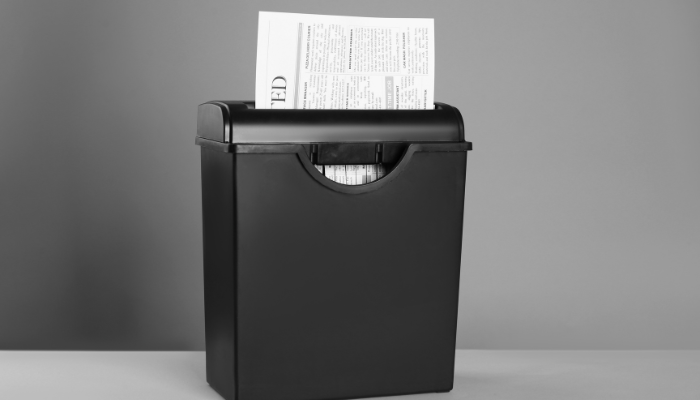electronics

August 06,2025 • 5 min read
What Happens to Documents After a Paper Shredder Does Its Job?

In today's data-driven world, information security is more important than ever. Whether it’s financial statements, medical records, or confidential client files, sensitive documents must be disposed of responsibly. That’s where a paper shredder comes in. But have you ever wondered what happens after your documents pass through a paper shredder machine?
Most people assume the job ends when the shredded strips fall into the bin—but that’s only part of the story. The journey of shredded paper continues through a detailed process of collection, transportation, recycling, and repurposing. In this blog, we at Pacific International take you behind the scenes to explore what really happens after your document shredder machine finishes its job.
Step 1: Collection and Storage of Shredded Paper
Once documents are shredded, the paper bits fall into a collection bin that is either built into the paper shredder machine or part of a larger waste system in offices. In small office setups, this bin is emptied into a general recycling bin. However, in commercial environments or businesses handling high volumes of sensitive data, shredded paper is stored in secured bins or bags and then handed over to licensed waste management providers.
These providers ensure that shredded material is never mixed with general waste, which helps maintain confidentiality even post-destruction.
Step 2: Transportation to Recycling Facilities
From your office or commercial space, the shredded paper is transported to a recycling plant. Most professional document disposal services have contracts with certified recycling companies that specialize in handling shredded materials.
One important thing to note is that document shredder machine output, especially from micro-cut models, can make recycling slightly more complicated. The smaller the particle, the harder it is to sort and recycle. However, reputable facilities are equipped to manage this efficiently.
Step 3: Sorting and Decontamination
At the recycling plant, the shredded paper is sorted and cleaned. This process involves:
- Screening: Removing any non-paper materials accidentally mixed with the shredded output (like plastic clips or binding).
- Decontamination: Eliminating ink, adhesives, and other substances that might hinder recycling.
The cleaned paper is then categorized based on quality and paper type. Shredded documents usually fall under "mixed paper" grade, which includes lower-quality paper products like used office paper, newspapers, and magazines.
Step 4: Pulping the Shredded Paper
Once sorted, the shredded material is mixed with water and chemicals to create a pulp. This pulp is thoroughly blended to break down the paper fibers, creating a slurry that can be processed into new paper products.
This step plays a vital role in the circular economy, ensuring that the remnants of your confidential files are transformed into something useful—without compromising data security.
Step 5: Repurposing into New Products
The recycled paper pulp is used to manufacture a variety of products, such as:
- Tissue paper
- Cardboard boxes
- Paper towels
- Office stationery
- Newspaper
In some cases, recycled pulp may be mixed with virgin fibers to improve strength and durability, especially for high-grade paper.
At Pacific International, we believe in promoting sustainable practices. The use of a paper shredder not only safeguards your information but also contributes to reducing environmental impact by supporting the recycling ecosystem.
Security Doesn't End at Shredding
It’s important to understand that using a document shredder machine is the first step in responsible document disposal. While shredding makes it nearly impossible to reconstruct documents, additional measures such as choosing the right shredder type and working with certified recyclers ensure that your sensitive information never lands in the wrong hands.
For example:
- Strip-cut shredders are faster but less secure.
- Cross-cut and micro-cut paper shredder machines provide more security by reducing paper to unreadable fragments.
- High-security shredders are used for top-secret government and military documents, turning paper into fine dust.
At Pacific International, we offer a wide range of shredding solutions tailored to various security levels and operational needs. Whether you're a small business or a large corporation, we have a paper shredder machine that matches your data protection goals.
Environmental Benefits of Shredding and Recycling
Let’s not forget the environmental impact. By using a paper shredder, you ensure that your waste paper can be efficiently recycled. This helps:
- Reduce the need for virgin paper production
- Save trees and natural resources
- Minimize landfill waste
- Lower greenhouse gas emissions
A single ton of recycled paper saves up to 17 trees, 380 gallons of oil, and 7,000 gallons of water. When your shredded documents enter the recycling stream, you play a part in conserving the environment.
Final Thoughts
A paper shredder is more than just a security tool—it’s part of a larger lifecycle that involves data protection, environmental responsibility, and resource efficiency. From the moment your document passes through the blades of a document shredder machine, it embarks on a sustainable journey that ends with its transformation into something new and useful.
At Pacific International, we’re proud to support businesses and individuals in their mission to stay secure and sustainable. Explore our range of advanced paper shredder machines, designed for durability, performance, and peace of mind.
Secure your documents. Support the planet. Choose Pacific International.
Pacific International Details
User Profile
- Full name
- Pacific International
- Email address
- seo@pacificinternational.info
- Join Date
- 2025-06-16
- State
- City
- Pincode
- Address
- Follow us on Facebook
- Follow us on Twitter
- Website Name
- Bio